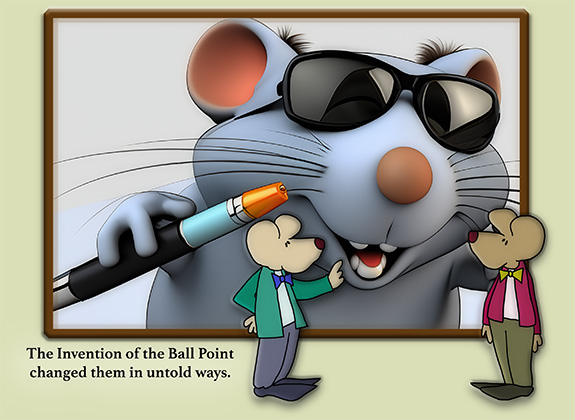Click it.
Or uncap it.
Either way. Set your ink down on paper. Easily.
For on this date, October 29, 1945, the very first ballpoint pen went on sale here in the United States. Reynolds manufactured it and just beat out Brio to the store shelves.
We all know them. The ballpoint pen.
But in different lands, it is called different things. In England, it is known as a biro. In Hong Kong, Indian, and Philippine English, it is a ball pen. Other parts of the world call them dot pens.
Oh, the beauty of such a little thing. It is a pen that dispenses ink over a metal ball at its point. Hence, the name.
The design was conceived and developed as a more reliable alternative to dip pens and fountain pens. These days, it is the world’s most-used writing instrument. I love, love, love a really good ballpoint pen.
They seem harder to find, I think. There are all sorts of new-fangled “gel” pens and roller pens.
Just put a good old Bic in my hands and let Polly Wolly Doodle All The Day.
It seems weird to me that it took so long to get to the stores.
I mean, the first patent for a ballpoint pen was issued on October 30, 1888, to John J. Loud. He was attempting to make a writing instrument that would be able to write “on rough surfaces—such as wood, coarse wrapping paper, and other articles.” Apparently, fountain pens could not.
It did well on rough surfaces but not so good on paper. So, it had no commercial viability. The whole potential of that pen went by the wayside. And just like that, the patent eventually lapsed.
Fast forward many years.
A guy named László Bíró came along. He was a Hungarian newspaper editor with a lot of those crazy slash marks over his name. He became frustrated by the amount of time that he wasted filling up fountain pens and cleaning up smudged pages. No wonder, with all those slash marks over his name.
He and his brother developed a new design for that ballpoint apparatus. Bíró filed for a British patent on June 15, 1938.
In 1941, the Bíró brothers and a friend, Juan Jorge Meyne, fled Germany and moved to Argentina, where they formed “Bíró Pens of Argentina” and filed a new patent in 1943.
So. How did it get to America? Well, Milton Reynolds came across a Birome ballpoint pen during a business trip to Buenos Aires, Argentina. He saw what a little goldmine he had in his hand. Yes, he could see all of that commercial potential and purchased several ballpoint samples. When he returned to the United States, he founded the Reynolds International Pen Company.
Reynolds bypassed the Birome patent with sufficient design alterations to obtain an American patent.
The pen debuted at Gimbels department store in New York City US $12.50 each. If you compare the 1945 US dollar value to current times, the pen would have cost about $205 in 2023.
At any rate, they called it the “Reynolds Rocket” — the first commercially successful ballpoint pen. Reynolds put on a great marketing show. As such, Gimbel’s sold many thousands of pens within one week.
But as it turned out Reynold’s ballpoint did not live up to consumer expectations in America. Ballpoint pen sales peaked in 1946. But then consumer interest fell off due to market saturation. By the early 1950s the ballpoint boom had subsided, and Reynolds’ company folded.
I don’t use pen and paper much anymore. Most of what I write and draw is digital. But I’m glad for the invention of the ballpoint. Carrying around an inkwell all those years would have been bothersome. And knowing me, probably messy.
“””””””””””””
“It ain’t whatcha write, it’s the way atcha write it.”
— Jack Kerouac
“””””””””””””
“We are all apprentices in a craft where no one ever becomes a master.”
—Ernest Hemingway
“””””””””””””
“We’re past the age of heroes and hero kings. … Most of our lives are basically mundane and dull, and it’s up to the writer to find ways to make them interesting.”
—John Updike
“””””””””””””
Inky. Ink. A dink a do. Roll with it, baby.
